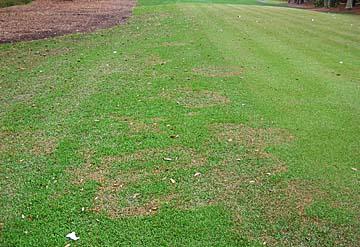 Although zoysiagrasses have been around for more than 100 years, they still encounter, comparatively speaking, some rather new world problems.
Although zoysiagrasses have been around for more than 100 years, they still encounter, comparatively speaking, some rather new world problems.Chief among those challenges associated with managing Zoysia japonica and Zoysia matrella for use on golf course fairways is large patch.
"Everything takes place when the turf is dormant or only actively growing enough that we don't see the symptoms right away, so it's difficult to know what is going on and how to get a good handle on it," said Brandon Horvath, Ph.D., turfgrass pathologist at the University of Tennessee. "A lot of work still needs to be done on it. Here at Tennessee we've been interested in conducting efficacy trials on fungicides. The challenge we've had is getting repeatable, reliable disease events and treatment intervals."
A disease of the pathogen Rhizoctonia solani, large patch is a blight of warm-season grasses and is especially troublesome in zoysiagrasses. Symptoms manifest as light green patches that can become yellow and then brown. It typically strikes in fall and spring as the growing season winds down and again begins to heat up. It also affects Bermudagrasses, which typically can recover rather quickly. Zoysiagrasses, however, can be adversely affected for several weeks.
One of the problems associated with large patch is that few things with it are black and white. There are a lot of gray areas when dealing with this disease.
Typically associated with cooler conditions in fall and spring when turf is dormant or just hanging onto active growth, large patch has been detected well into the heart of the growing season.
"There has not been enough research conducted on this pathogen or the disease cycle," Horvath said.
What researchers do know is that outbreaks in fall and spring are two different animals. It is possible, when dealing with infestations in spring, that the grass can naturally grow out of large patch. Outbreaks in the fall, as the turf heads into dormancy, can be devastating if left untreated.
"They are separate. Now, with that said, if you make applications in the fall you lower the probability of a significant outbreak in the spring," Horvath said. "The fall epidemic is in my mind the critical one to control."
Although more research on the topic is needed, the typical treatment includes two preventive fungicide applications. In the fall, the first application should be made when temperatures in early autumn first reach about 70 degrees, with the second coming 28 days later, and ideally when temperatures are still in the low 60s.
The first spring application should be made when temperatures are in the low 60s, with the follow-up coming four weeks later when temperatures, again ideally are at about the 70-degree mark.
DMI fungicides, along with QOI's have been shown to elicit very high rates of success. Still, nothing with large patch is ever absolute.
Megan Kennelly, Ph.D., turfgrass pathologist at Kansas State, told TurfNet last year that disease outbursts even after spraying are not uncommon.
"You can still get some breakthroughs even when you spray," Kennelly said. "Even if you spray multiple times in the fall."
Large patch has been a problem on Meyer zoysia just about since its inception in 1941. Micah Woods, Ph.D., of the Asian Turfgrass Center has written about his observations that show Zoysia japonica to be more susceptible than Zoysia matrella to the disease-causing pathogen. But when outbreaks on the latter do occur in this country it causes more of a stir because of the use of Zoysia matrella as fairway cover on high-end courses throughout the southern end of the transition zone.
"The real challenge for superintendents is a cost issue," Horvath said. "Fungicide applications on fairways in the North, that's just another day in the life. They have to do that if they are a high-end facility. In the transition zone the mindset is that you have to make two applications in the fall and two in the spring, but you don't want to be spraying all the time."
It is important that superintendents and their committees communicate proactively to determine acceptable levels of disease outbreak in fairways and base programs on those expectations and cost factors.
"We have to balance what we can recommend on data that we have with the understanding that the information is imperfect," Horvath said. "We can get good control, but we have to educate golfers and the front office that rarely are there things that are a sure bet.
"That's what we strive to push with our students. You have to communicate what it is that you are doing; what your successes are and what the failures are. The problem isn't disease, the problem is when you hide in your office and pretend there isn't a problem."

